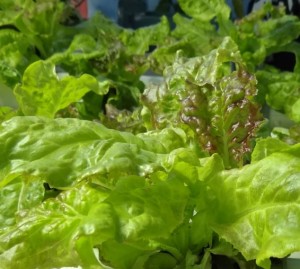Spring in Ohio brings about the availability of fresh, local grown lettuce varieties and greens. The four major lettuce varieties you are likely to see include: Butterhead, Ice berg, Loose Leaf, and Romaine. While all lettuce varieties are part of a healthy diet, the darker the leaf the more nutritious(PDF) they tend to be. Lettuce varieties and greens are low in calories, fat and sodium. They are typically a good source of beta-carotene, fiber, and folate. Beta-carotene, often found in dark green vegetables, plays an important role in skin and eye health as well as protecting against infection. The folate in these vegetables has also been linked to the reduced risk of birth defects. New research is also showing that eating one to two servings of leafy green vegetables a day may help maintain cognitive abilities as you age, and protect against Alzheimer’s disease and dementia. If your family members find some of the darker green leaves bitter, try mixing them with traditional green leaf lettuce or Iceberg to encourage increased nutrient consumption.
berg, Loose Leaf, and Romaine. While all lettuce varieties are part of a healthy diet, the darker the leaf the more nutritious(PDF) they tend to be. Lettuce varieties and greens are low in calories, fat and sodium. They are typically a good source of beta-carotene, fiber, and folate. Beta-carotene, often found in dark green vegetables, plays an important role in skin and eye health as well as protecting against infection. The folate in these vegetables has also been linked to the reduced risk of birth defects. New research is also showing that eating one to two servings of leafy green vegetables a day may help maintain cognitive abilities as you age, and protect against Alzheimer’s disease and dementia. If your family members find some of the darker green leaves bitter, try mixing them with traditional green leaf lettuce or Iceberg to encourage increased nutrient consumption.
To select the best lettuce or greens look for crisp leaves and avoid brown edges. Handle leaves with care, as they often bruise easily. Store lettuce and greens(PDF) refrigerated in a lettuce keeper or plastic bag, away from fruits like apples and bananas which will cause browning. To avoid risk of foodborne illness, observe use by dates on bagged lettuces and use local grown within a week. Rinse lettuce or greens well and carefully pat dry with paper towels or use a salad spinner to remove excess water. Unless you plan to eat the lettuce or greens right away, avoid chopping with a knife which will also cause browning.
Lettuce is an inexpensive meal choice great in wraps, on sandwiches, or in salads. The USDA What’s Cooking: Mixing Bowl is full of over 20 ideas to include more lettuce or greens in your meal plan if you are looking for a new idea for lunch or dinner. What will you try?

